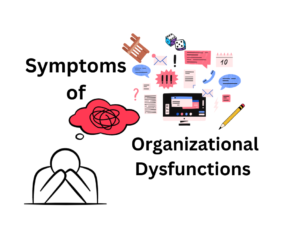Every organization goes through different phases and challenges, and organizations can unconsciously slip into dysfunctions. Many organizations continue to wallow in the swamp of dysfunction because they do not recognize its symptoms. They might notice a dip in performance, employee turnover, or some form of internal struggle. Instead of taking time to understand the depth of the dysfunctions, many leaders resort to band-aid approaches such as training, policy change, and employee incentives. These interventions can be useful, but only if done within a holistic approach after a thorough analysis of the problem.
Over the next few weeks, this blog series will review some signs of organizational dysfunctions that we have come across in our work. Before we get into the symptoms, it is important to define the meaning of organizational dysfunctions.
The word dysfunction means deviation from normal functioning or operation. Some synonyms of dysfunction include defective, unhealthy, unstable, broken, flawed, sick, and wounded. Organizational dysfunction means breaks in the system flow, gaps within the system, and disorderliness that create unhealthy environments that prevent organizations from operating to their full capacity or potential.
Organizational dysfunction does not just appear in organizations. While not always intentional, it is a result of actions and inactions. Craig Carroll stated, “organizational dysfunction is the product of structural, cultural, or leadership patterns that undermine the purpose, health, wholeness, safety, solidarity, and worth of an organization or its stakeholders.” Leadership decisions that have negative effects on the structure and culture of organizations lead to dysfunction.
The scariest aspect of dysfunction is that an organization could still be delivering value to its customers, clients, patients, members, or participants while operating in dysfunction. This usually leads to the slow demise of many organizations. Outwardly, people see a functional or proper organization, but internally there is a struggle. Because outsiders still consider the organization to be delivering value, the leaders usually brush aside the obvious signs of dysfunction. For example, they might blame the job market for employee turnover, saying:
“Turnover is not unique to us because everyone is experiencing the same thing.”
“It is a result of the great resignation.”
They can also blame it on industry or societal trends.
“Employees in our industry are usually less resolute or stay longer.”
“We don’t have the resources to deliver the best results or attract the best talents.”
“The pandemic is affecting everyone, and we are not exempted.”
The excuses above might be valid in specific circumstances, but they do not cover or cure dysfunctions. Dysfunctions amplify the usual challenges that every organization experiences. When leaders deny or hide dysfunctions, they become fully established problems.
Fully formed dysfunctions tend to disrupt the organizational system, gradually reduce organizational impacts, and eventually grind everything to a halt as we have seen in many great organizations that no longer exist.
Over the next few weeks, we will examine symptoms of dysfunctions such as:
- Complicated decision-making process
- Busyness
- Conflict avoidance
- Emailing everything

